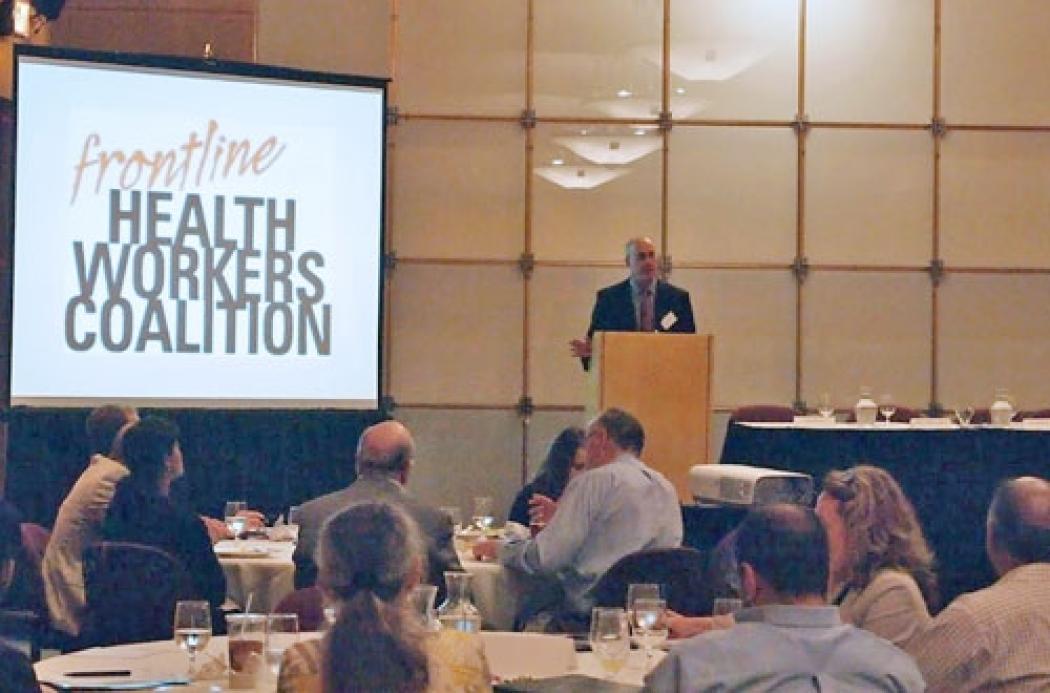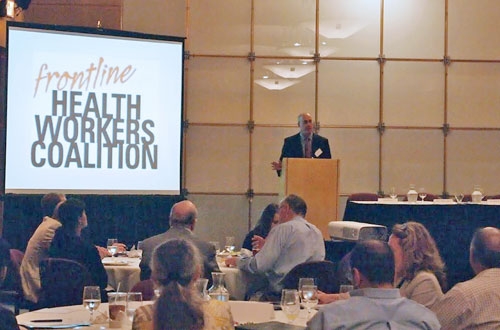The US Government and the Health Workforce Crisis: A Dialogue on Strategy and Approach

By: Laura Hoemeke, IntraHealth
The Frontline Health Workers Coalition held a technical meeting with representatives of the US Government on June 26, The US Government and the Health Workforce Crisis: A Dialogue on Strategy and Approach. The meeting brought together approximately 55 participants, including representatives of Coalition members and colleagues from the US Agency for International Development, the Centers for Disease Control and Prevention, the Office of Global AIDS Coordination, and the Health Resources and Services Administration (HRSA). The overall goal of the Coalition is to encourage the US government to adopt and implement a comprehensive strategy that will increase the number of frontline health workers and empower health providers who are serving communities in need. The purpose of the June 26 event was to begin the process of defining the content of a USG frontline health workers strategy.
“Health workers are at the heart of health care delivery,” said keynote speaker Ambassador Mark Dybul. “In a way, they are also the glue that holds together a continuum of prevention, care, and treatment. We need the right health workers in the right place to offer not only curative care, but also preventive services.” Ambassador Dybul served as the United States Global AIDS Coordinator leading the implementation of the President's Emergency Plan for AIDS Relief (PEPFAR) during the presidency of George W. Bush. He is currently a distinguished scholar and serves as co-director at Georgetown’s O'Neill Institute for National and Global Health Law. “We absolutely need more health workers,” Ambassador Dybul continued. “And we need to ensure that those serving are treated with the dignity they deserve.”
Dr. Caroline Ryan, Director of Technical Leadership at the US Government’s Office of the US Global AIDS Coordinator, talked about the need to support health workers “in the context of supporting all of the critical components of human resources for health.” Dr. Ryan described the progress being made towards achieving the PEPFAR goal of training and retaining 140,000 new health workers. She discussed the important partnership between the Department of Health and Human Services, Health Resources and Services Administration (HRSA), and PEPFAR and African medical and nursing schools to transform African medical and nursing education to dramatically increase the number of health workers. Through the Medical and Nursing Education Partnership Initiative (MEPI and NEPI, respectively), grants are awarded directly to African institutions, working in partnership with US medical schools and universities. Ryan spoke of the important role of doctors and nurses in supporting frontline health workers, and also of some of the challenges of addressing faculty retention.
Following the opening speeches, participants broke up into six working groups to address key issues of a US government strategy to support frontline health workers. The groups addressed: 1) priority countries, 2) objectives for strategy, 3) costing a strategy, 4) the technical framework for the strategy, 5) leadership and management of the strategy, and 6) measuring the impact of the strategy. Following the working group sessions, discussions emphasized the importance of the strategy focusing on frontline health workers, and the need to work closely with the US government to propose elements of a strategy that are feasible and measurable. Next steps will include the development of a series of policy briefs that will provide recommendations to the US government with regard to a USG health workforce strategy. The policy briefs will lay the groundwork for a continuing dialogue between the Coalition and key USG agencies.
Written by: Laura Hoemeke, IntraHealth International. IntraHealth is a member of the Frontline Health Workers Coalition, a dynamic and influential coalition of 25+ NGOs working together to urge greater and more strategic U.S. investment in frontline health workers in the developing world as the most cost-effective way to save lives and foster a healthier, safer and more prosperous world.

